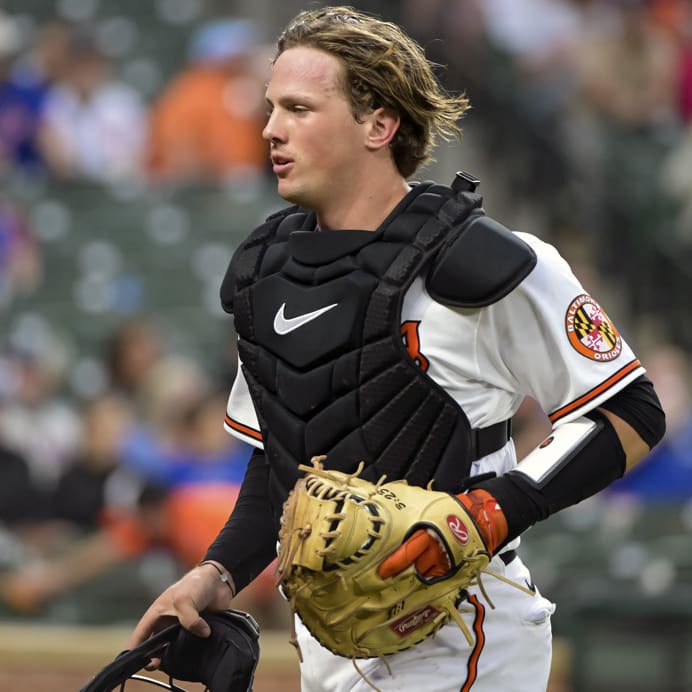This article is part of our Collette Calls series.
Player A Prospect Writeup in the 2012 Baseball America Prospect Handbook:
"His fastball sits at 92-96 mph, has been clocked as high as 98 and features good run and sink. His success in the second half of the season coincided with his willingness to pitch aggressively off his fastball, which allowed him to get ahead in the count more often. In turn, that helped him do a better job of setting up his slider, his most consistent and best all-around pitch. His slider operates in the mid-90s with hard, cutting tilt and impressive depth. He has improved his changeup over the past two seasons, but it's average at best. His mechanics are fine, which leaves most observers to believe his command issues result from his inconsistent focus and mental approach. His inability to throw consistent strikes leads some scouts to suggest that he could wind up in the bullpen, perhaps even as a closer."
Player B Prospect Writeup in the 2012 Baseball America Prospect Handbook:
"His fastball velocity is on the rise, reaching 96 mph last summer after sitting at 90-93 for most of the spring. His big-breaking curveball shows flashes of becoming a plus pitch, and his changeup is rudimentary at this point. He'll need to lean on his athleticism as he learns to repeat his delivery and improve his command. He is certainly someone to dream
Player A Prospect Writeup in the 2012 Baseball America Prospect Handbook:
"His fastball sits at 92-96 mph, has been clocked as high as 98 and features good run and sink. His success in the second half of the season coincided with his willingness to pitch aggressively off his fastball, which allowed him to get ahead in the count more often. In turn, that helped him do a better job of setting up his slider, his most consistent and best all-around pitch. His slider operates in the mid-90s with hard, cutting tilt and impressive depth. He has improved his changeup over the past two seasons, but it's average at best. His mechanics are fine, which leaves most observers to believe his command issues result from his inconsistent focus and mental approach. His inability to throw consistent strikes leads some scouts to suggest that he could wind up in the bullpen, perhaps even as a closer."
Player B Prospect Writeup in the 2012 Baseball America Prospect Handbook:
"His fastball velocity is on the rise, reaching 96 mph last summer after sitting at 90-93 for most of the spring. His big-breaking curveball shows flashes of becoming a plus pitch, and his changeup is rudimentary at this point. He'll need to lean on his athleticism as he learns to repeat his delivery and improve his command. He is certainly someone to dream on, a potential frontline starter if things break right."
The first pitcher is Chris Archer, who the Rays recently traded to the Pittsburgh Pirates the last year he was eligible as a prospect in the Rays system. Archer went 7-9 with a 3.66 ERA and a 15 percent K-BB% in Triple-A Durham that season and 1-3 with a 4.60 ERA and 19 percent K-BB% in a late-season promotion to the big league club.
The second pitcher is one of the players Tampa Bay acquired when they sent Archer to Pittsburgh, Tyler Glasnow. Glasnow was ranked five times from 2012 through 2016 by Baseball America. He debuted at No. 19 in 2012, and then was ranked either first or third in each of the next four years ending in 2016 with the following write-up:
"Glasnow's added strength gave him outstanding raw stuff, topped by a 92-95 mph fastball that hits 99 and a wipeout curveball. He also throws his changeup at 90 mph, and the pitch is showing signs of being a third plus weapon. He has allowed a career .172 opponent average in 500 minor league innings. Walks, however, have been a major problem … He has the ceiling of a No. 1 starter, but many evaluators outside the organization believe his futures lies as a reliever due to his poor control."
Archer came to the majors with an uncertain future as a front of the rotation pitcher or a closer. Fast forward six seasons, and Glasnow comes to the team with a similar uncertain future. He has 148 innings at the big league level with a 5.64 ERA and a 11 percent K-BB% rate. He started 17 of his 22 outings before this season, but his only two starts in 2018 are the two opening appearances he has made with his new club. It are those two appearances I want to focus on here because he has been incredibly impressive in both outings. I referenced the Chris Archer scouting report as he made it to the major leagues because I am experiencing some deja vu watching Glasnow pitch in his new uniform because I feel like I am watching Archer's ascension to a frontline starter all over again.
Each pitcher has had two starts for a new organization with well-established philosophies on pitching, and I would like to see if either has changed in-season since trading addresses. We'll begin with the veteran Archer.
Pittsburgh's pitching philosophy is proselytized by its long-time pitching coach, Ray Searge. It is a simple philosophy: Throw first-pitch strikes, stay aggressive with the fastball, pitch inside and low in the zone. In an age where teams, as a whole, throw fewer fastballs and emphasizing other pitches, the Pirates lead the league in percentage of fastballs thrown by starting pitchers. That philosophy is one seemingly designed around pitching to the defense behind you than one designed around striking batters out, which is antithetical on the surface to how Archer has pitched for his career. Archer has primarily been a two-pitch pitcher that has struggled to go deep into games because of the amount of foul balls off him which leads to inefficient pitch count innings.
Archer's two outings for the Buccos have not exactly been barn burners. He has permitted 18 baserunners in 9.1 innings while allowing a home run in each, striking out nine, and not recording 16 outs in either one. To be fair, the second outing came at Coors Field, and he actually pitched better there than he did in his home debut and got a win for his efforts. Let's take a look at the pitch mixture and location to see if Ray Searge is making any adjustments to Archer or if it will be a continuation of what Archer was doing with Tampa Bay.
The first pie chart below is Archer's pitch mixture with Tampa Bay over 1,598 pitches while the second one represents what he has done over two starts in Pittsburgh over 193 pitches:
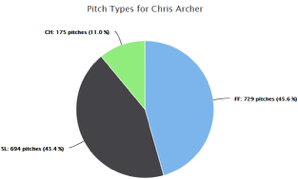

There has been a small spike in fastball utilization, and even more sliders while the changeup continues to get marginalized. Archer's changeup has never really been more than a show-me pitch, so that is a good thing. The slider has lost a ton of its value this year by pitch value; a pitch that has been one of the best in the league has barely been above league average this year.
Pitching low and inside will be something to watch, because Archer rarely pitched inside intentionally with Tampa Bay. He worked up with the fastball, mostly over the outer half of the plate, and the slider's ideal location was something that began on the outer third and then dove out of the zone around the end of the hitter's bat. This is what that looked like to right-handed hitters while Archer pitched in Tampa Bay this year:
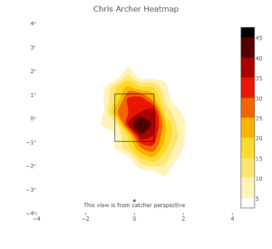
This is what that same type of pitch map has looked like to right-handed hitters over Archer's two starts with Pittsburgh:
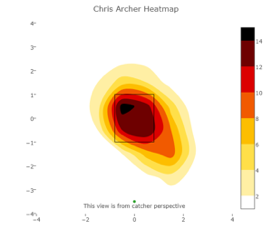
Not exactly low and inside with the fastball, but there is is a discernible difference between the two images in that Archer appears to finally be taking to pitching inside with his fastball. The results have not yet shown up in his line score, but this was long a sore spot with me in watching him over the years and something I felt led to his overexposure to the American League East where the familiar foes got increasingly comfortable with him over the years. They eventually knew they had to look for two pitches, and that they could effectively eliminate one-third of the plate when they were up there. Why is this important? Check out Archer's numbers against righties the past few seasons:
| YEAR | TBF | AVG | BABIP | HARD% |
| 2014 | 351 | .259 | .315 | 27 |
| 2015 | 410 | .218 | .295 | 33 |
| 2016 | 440 | .242 | .306 | 33 |
| 2017 | 451 | .230 | .300 | 36 |
| 2018 | 266 | .263 | .347 | 41 |
As with any change, the results may not show up immediately, but it is encouraging to see Archer make some adjustments under the tutelage of a new coach with an incredible reputation for helping pitchers get the most of their abilities. The cerebral pair should work well together, and perhaps we will even see a cutter added in the offseason to pair off the slider and give Archer something else to use as a third pitch because the changeup is not cutting it.
Then we get to another interesting pairing in Tyler Glasnow and Kyle Snyder. Both the pitcher and the pitching coach are 6-foot-8, and that is where the similarities end. Glasnow throws 99, while Snyder only dreamt of throwing that hard in his playing days. What he does have in common with his young pupil is an understanding of the complexities of pitching with long limbs and how it can lead to command problems. Glasnow has found the strike zone with 44 percent of his major league pitches, and has a 53 percent first-pitch strike rate for his career; both numbers are below the league average. Compound that with the fact he is very slow to the plate and has extreme difficultly controlling the running game, and you have the quandary the Pirates had with him: too risky for late innings but not enough command to get 18 outs as a starter. The club instead used him mostly a multi-inning reliever in the middle of games as he made 26 of his 34 appearances between the fourth and seventh innings in Pittsburgh. The first month of his season was horrendous, as by May 1, he had a 7.71 ERA in his first 16.1 innings while allowing 28 baserunners and 14 earned runs, all while striking out 23 batters. In short, when he did not strike a guy out, they were very safely putting the ball in play and scoring nearly at will. He went on to finish his time in Pittsburgh with a 2.95 ERA over his final 39.2 innings with 49 strikeouts.
Glasnow moving to Tampa Bay is a logical fit as they appear to be married to this opener strategy for the rest of this season, and even 2019. Blake Snell and Jake Faria are the only two locks next year for the rotation. The jury is still out on whether Yonny Chirinos can be a starting pitcher, and Brent Honeywell won't be seen until the latter third of the 2019 season. There is not a starter coming up from Durham and the team never skips levels with pitchers. The only relief on its way up soon comes in the forms of Colin Poche and Ian Gibaut. Poche has been a very effective multi-inning reliever in Durham who has 64 strikeouts and 19 hits allowed in 39.1 innings this season. Gibaut has finished 27 of 38 games in Durham with 58 strikeouts while allowing 30 hits in 46 innings. The team could sign a free agent to get a fourth starter behind Snell, Faria and Glasnow, but Jonny Bullpen figures to be a prominent part of the rotation again next year, especially if the club decides that stretching Glasnow out is not in his best interest.
Glasnow threw 48 pitches in his first outing, and 61 in the most recent one this week. Those pitch totals represent his second and sixth-highest pitch totals of the season. He too is adjusting to a new philosophy of pitching, coming from a place that preaches working down in the zone to one that emphasizes working up and down in the zone while painting the corners with the breaking stuff. Changing eye levels and keeping guys guessing was something that Jim Hickey began 10-plus years ago and the philosophy was engrained into Kyle Snyder as he came up in the system as a coach. Of late, the new wrinkle has been the club throwing more sinkers that four-seam fastballs so there has been more pitching down than up, but this is still an overall change for Glasnow.
The first heat map is how Glasnow attacked all hitters with Pittsburgh while the second map is how he has pitched with Tampa Bay:
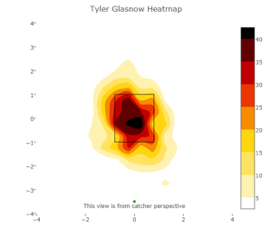

You can see the Tampa Bay philosophy taking shape on Glasnow's bottom heat map as well as Pittsburgh's philosophy impacting the top one. By pitch type, there has been little difference in how Glasnow has attacked batters as he has thrown his fastball 73 percent of the time in both locations with the slider and curveball making up the rest of the utilization.
Earlier, I cited Glasnow's career rates of 44 percent for locating pitches in the strike zone and 53 percent for throwing first-pitch strikes. Over his first two starts in Tampa Bay, those rates are 51 percent and 64 percent, and his swinging strike rate has surged from 12 percent to 17 percent. He has generated 15 swings and misses off the 79 fastballs he has thrown with Tampa Bay, which is just two less than he did in July with Pittsburgh on 167 fastballs.
Just watch this highlight clip of Glasnow the other night against Baltimore and try not to be as excited as I am:
It is all there. Fastballs up, fastballs down, and breaking balls to the corners that are pseudo-strikes that dive out of the zone. That type of outing is what his stuff is capable of when everything is in sync, and right now, Glasnow looks measurably better than he did most times this year in Pittsburgh.
This isn't to say that either pitching coach or philosophy is better than the other, but more that certain guys fit better into certain approaches. Throwing 99 up and away in the zone is a very tough pitch to hit, and tunneling that with 83-86 mph breaking pitches that dive out of the zone is why the league-wide batting average continues to fall. Conversely, any pitcher that works both sides of the plate should see better results than one that ignores the inner third of the plate out of fear of hitting batters or worrying that it plays into the pull tendencies of most hitters these days.








